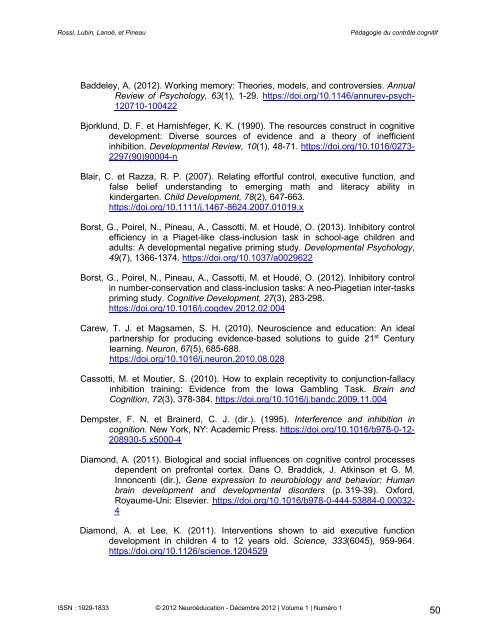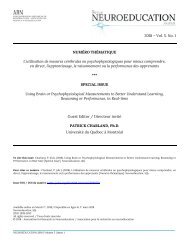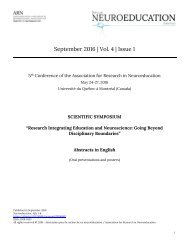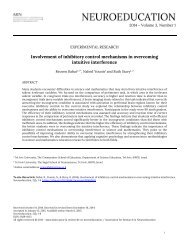Neuroeducation_2012_vol-1_no-1_full
Neuroeducation journal - Volume 1, Issue 1 (2012) - 144 pages
Neuroeducation journal - Volume 1, Issue 1 (2012) - 144 pages
Create successful ePaper yourself
Turn your PDF publications into a flip-book with our unique Google optimized e-Paper software.
Rossi, Lubin, La<strong>no</strong>ë, et Pineau<br />
Pédagogie du contrôle cognitif<br />
Baddeley, A. (<strong>2012</strong>). Working memory: Theories, models, and controversies. Annual<br />
Review of Psychology, 63(1), 1-29. https://doi.org/10.1146/annurev-psych-<br />
120710-100422<br />
Bjorklund, D. F. et Harnishfeger, K. K. (1990). The resources construct in cognitive<br />
development: Diverse sources of evidence and a theory of inefficient<br />
inhibition. Developmental Review, 10(1), 48-71. https://doi.org/10.1016/0273-<br />
2297(90)90004-n<br />
Blair, C. et Razza, R. P. (2007). Relating effortful control, executive function, and<br />
false belief understanding to emerging math and literacy ability in<br />
kindergarten. Child Development, 78(2), 647-663.<br />
https://doi.org/10.1111/j.1467-8624.2007.01019.x<br />
Borst, G., Poirel, N., Pineau, A., Cassotti, M. et Houdé, O. (2013). Inhibitory control<br />
efficiency in a Piaget-like class-inclusion task in school-age children and<br />
adults: A developmental negative priming study. Developmental Psychology,<br />
49(7), 1366-1374. https://doi.org/10.1037/a0029622<br />
Borst, G., Poirel, N., Pineau, A., Cassotti, M. et Houdé, O. (<strong>2012</strong>). Inhibitory control<br />
in number-conservation and class-inclusion tasks: A neo-Piagetian inter-tasks<br />
priming study. Cognitive Development, 27(3), 283-298.<br />
https://doi.org/10.1016/j.cogdev.<strong>2012</strong>.02.004<br />
Carew, T. J. et Magsamen, S. H. (2010). Neuroscience and education: An ideal<br />
partnership for producing evidence-based solutions to guide 21 st Century<br />
learning. Neuron, 67(5), 685-688.<br />
https://doi.org/10.1016/j.neuron.2010.08.028<br />
Cassotti, M. et Moutier, S. (2010). How to explain receptivity to conjunction-fallacy<br />
inhibition training: Evidence from the Iowa Gambling Task. Brain and<br />
Cognition, 72(3), 378-384. https://doi.org/10.1016/j.bandc.2009.11.004<br />
Dempster, F. N. et Brainerd, C. J. (dir.). (1995). Interference and inhibition in<br />
cognition. New York, NY: Academic Press. https://doi.org/10.1016/b978-0-12-<br />
208930-5.x5000-4<br />
Diamond, A. (2011). Biological and social influences on cognitive control processes<br />
dependent on prefrontal cortex. Dans O. Braddick, J. Atkinson et G. M.<br />
In<strong>no</strong>ncenti (dir.), Gene expression to neurobiology and behavior: Human<br />
brain development and developmental disorders (p. 319-39). Oxford,<br />
Royaume-Uni: Elsevier. https://doi.org/10.1016/b978-0-444-53884-0.00032-<br />
4<br />
Diamond, A. et Lee, K. (2011). Interventions shown to aid executive function<br />
development in children 4 to 12 years old. Science, 333(6045), 959-964.<br />
https://doi.org/10.1126/science.1204529<br />
ISSN : 1929-1833 © <strong>2012</strong> Neuroéducation - Décembre <strong>2012</strong> | Volume 1 | Numéro 1<br />
50








